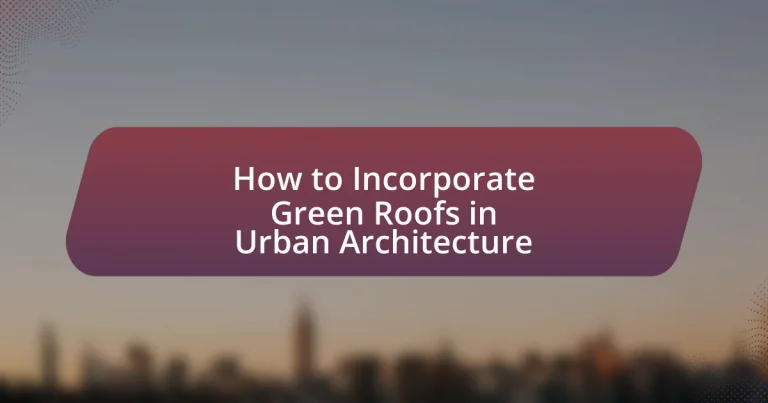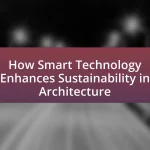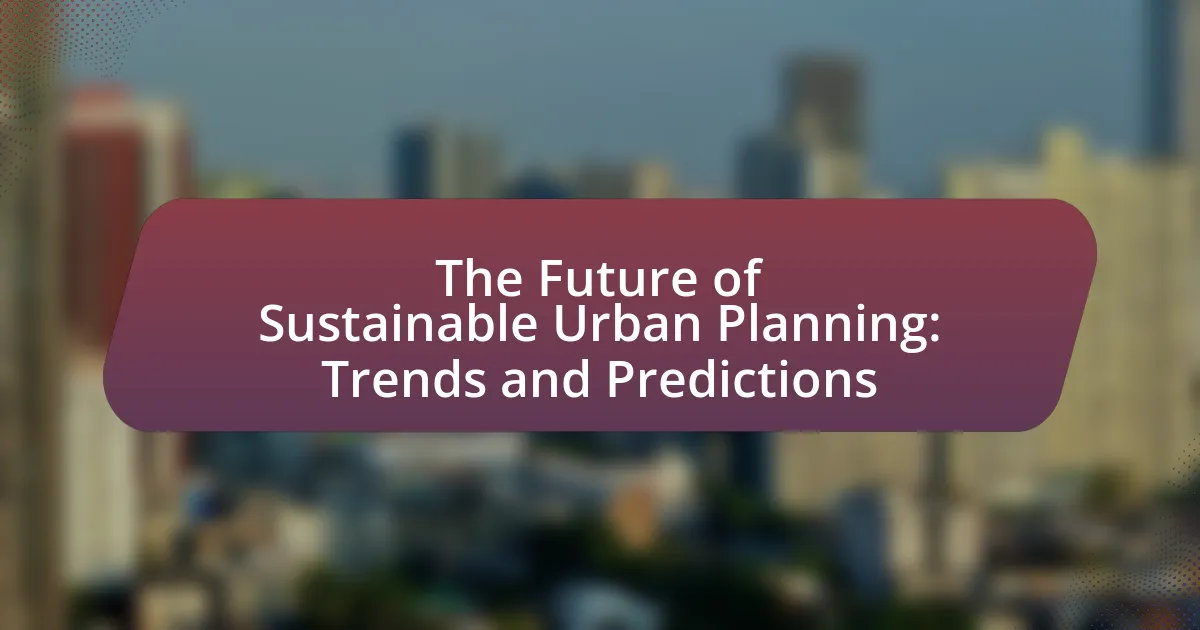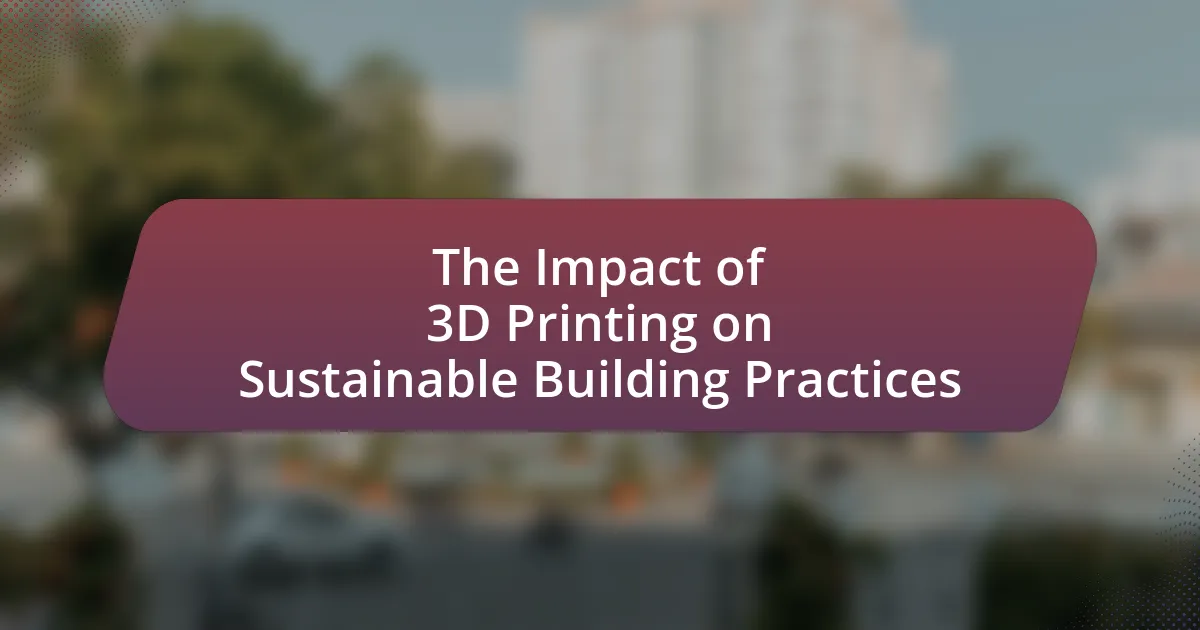Green roofs are vegetated systems installed on building rooftops that offer numerous environmental, economic, and social benefits in urban architecture. They help mitigate urban heat islands, improve air quality, and manage stormwater runoff, while also enhancing biodiversity by providing habitats for various species. The article explores the types of green roofs, their contributions to urban sustainability, and the key design considerations for effective integration into urban settings. It also addresses challenges in adoption, innovative solutions, and best practices for successful implementation, emphasizing the importance of community engagement and education in promoting green roofs as a sustainable urban development strategy.
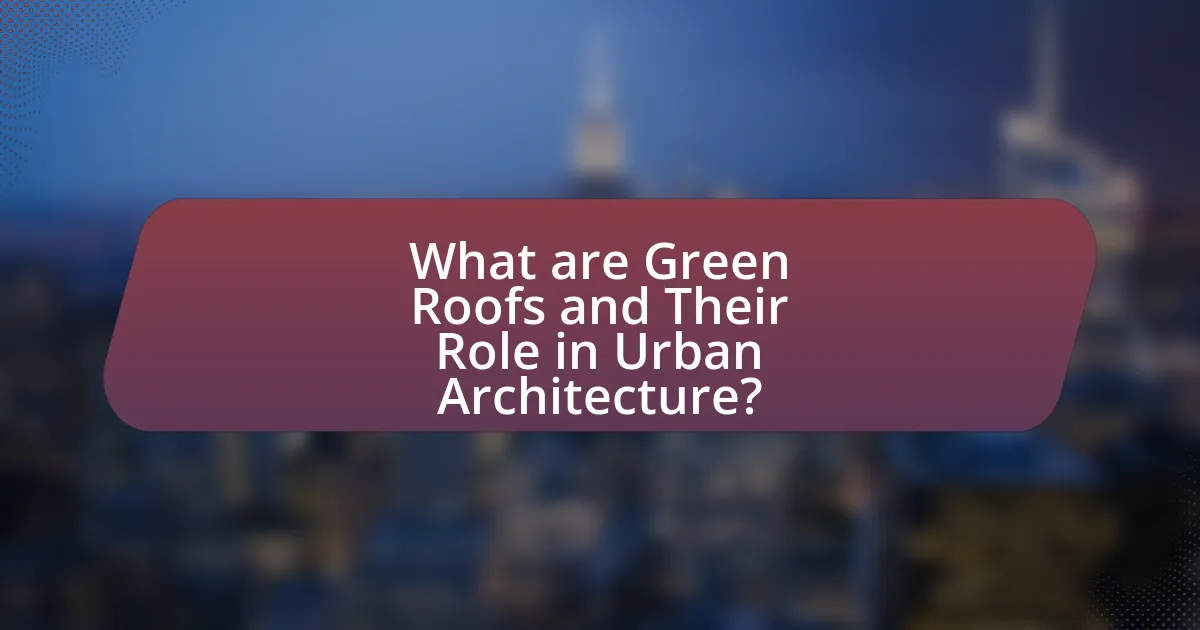
What are Green Roofs and Their Role in Urban Architecture?
Green roofs are vegetated systems installed on building rooftops that provide environmental, economic, and social benefits in urban architecture. They play a crucial role in mitigating urban heat islands, improving air quality, and managing stormwater runoff by absorbing rainwater. Studies indicate that green roofs can reduce building energy consumption by up to 25% by providing natural insulation. Additionally, they enhance biodiversity by creating habitats for various species in urban settings. The implementation of green roofs aligns with sustainable urban development goals, promoting resilience against climate change and improving the overall quality of life in cities.
How do green roofs contribute to urban sustainability?
Green roofs contribute to urban sustainability by enhancing biodiversity, improving air quality, and reducing urban heat islands. These roofs provide habitats for various plant and animal species, thus promoting ecological diversity in urban settings. Additionally, they filter pollutants from the air, leading to cleaner urban environments. Studies indicate that green roofs can lower ambient temperatures by up to 5 degrees Celsius, mitigating the urban heat island effect, which is crucial for energy conservation and reducing reliance on air conditioning. Furthermore, green roofs manage stormwater by absorbing rainwater, which decreases runoff and reduces the risk of flooding in urban areas.
What environmental benefits do green roofs provide?
Green roofs provide significant environmental benefits, including improved air quality, reduced urban heat island effect, and enhanced biodiversity. Specifically, green roofs filter pollutants and carbon dioxide from the air, contributing to cleaner urban environments. Studies indicate that green roofs can lower surrounding temperatures by up to 5 degrees Fahrenheit, mitigating the urban heat island effect, which is crucial in densely populated areas. Additionally, they create habitats for various species, promoting biodiversity in urban settings. Research published in the journal “Ecological Engineering” highlights that green roofs can support a range of plant and animal life, thereby enhancing ecological resilience in cities.
How do green roofs impact urban heat islands?
Green roofs significantly mitigate urban heat islands by reducing surface temperatures through vegetation cover and evapotranspiration. The presence of plants on rooftops absorbs sunlight, which lowers the heat retained by traditional roofing materials. Studies indicate that green roofs can lower ambient temperatures by up to 5 degrees Celsius compared to conventional roofs, contributing to cooler urban environments. Additionally, the cooling effect of green roofs can lead to reduced energy consumption for air conditioning in nearby buildings, further alleviating the urban heat island effect.
What types of green roofs are commonly used in urban settings?
The types of green roofs commonly used in urban settings are extensive green roofs, intensive green roofs, and semi-intensive green roofs. Extensive green roofs feature a lightweight substrate and require minimal maintenance, making them suitable for large areas and less accessible rooftops. Intensive green roofs, on the other hand, have a deeper substrate that supports a wider variety of plants, including shrubs and small trees, but require more maintenance and irrigation. Semi-intensive green roofs combine elements of both extensive and intensive systems, allowing for a moderate variety of plant life while still being manageable in terms of maintenance. These classifications are supported by studies indicating their effectiveness in improving urban biodiversity, reducing heat island effects, and managing stormwater runoff.
What distinguishes extensive green roofs from intensive green roofs?
Extensive green roofs are characterized by a shallow substrate layer, typically 2 to 6 inches deep, and are designed to support low-maintenance vegetation such as sedums and grasses. In contrast, intensive green roofs have a deeper substrate, usually exceeding 6 inches, allowing for a wider variety of plants, including shrubs and small trees, which require more maintenance and irrigation. The distinction lies in the depth of the growing medium and the types of vegetation supported, with extensive roofs being more lightweight and less resource-intensive compared to the heavier, more complex intensive roofs.
How do modular green roofs differ from traditional systems?
Modular green roofs differ from traditional systems primarily in their design and installation process. Modular green roofs consist of pre-planted, lightweight trays or modules that can be easily transported and installed, allowing for quicker assembly and less disruption during installation. In contrast, traditional green roofs typically involve a more complex layering system that requires on-site planting and can take longer to establish. Research indicates that modular systems can reduce installation time by up to 50% compared to traditional methods, making them a more efficient option for urban architecture.
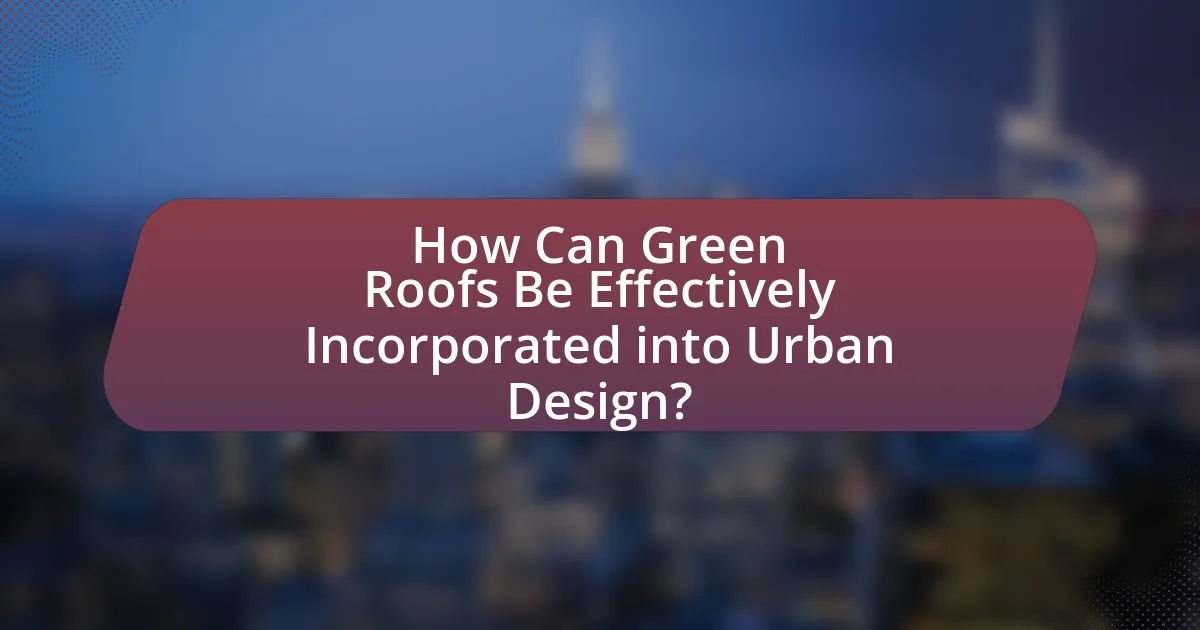
How Can Green Roofs Be Effectively Incorporated into Urban Design?
Green roofs can be effectively incorporated into urban design by integrating them into building codes and zoning regulations, ensuring that new developments include green roof systems. This approach promotes biodiversity, reduces urban heat, and manages stormwater runoff. For instance, cities like Toronto have implemented policies that require green roofs on new commercial buildings, resulting in a 50% reduction in stormwater runoff and improved air quality. Additionally, incorporating green roofs into public spaces and community projects enhances aesthetic appeal and provides recreational areas, further supporting urban sustainability goals.
What are the key design considerations for integrating green roofs?
Key design considerations for integrating green roofs include structural load capacity, plant selection, irrigation systems, and waterproofing. Structural load capacity is crucial as green roofs add significant weight; therefore, buildings must be engineered to support this additional load. Plant selection should focus on native and drought-resistant species to ensure sustainability and reduce maintenance needs. Irrigation systems must be designed to efficiently manage water use, often incorporating rainwater harvesting or drip irrigation to minimize waste. Waterproofing is essential to prevent leaks and protect the building’s integrity, necessitating high-quality membranes and proper installation techniques. These considerations are supported by studies indicating that well-designed green roofs can enhance urban biodiversity, improve air quality, and reduce energy consumption.
How does building structure influence green roof design?
Building structure significantly influences green roof design by determining load-bearing capacity, drainage systems, and overall integration with the architectural framework. The structural integrity of a building dictates the types of green roofs that can be implemented, such as extensive or intensive systems, which require different soil depths and plant selections. For instance, a study by the National Research Council of Canada highlights that buildings must support the additional weight of soil and vegetation, which can range from 15 to 100 pounds per square foot, depending on the design. Additionally, the building’s roof slope and orientation affect water drainage and sunlight exposure, crucial for plant health. Therefore, the design and materials of the building structure are critical in shaping effective and sustainable green roof solutions.
What role does local climate play in green roof planning?
Local climate significantly influences green roof planning by determining plant selection, irrigation needs, and structural design. For instance, regions with high temperatures and low rainfall require drought-resistant plants and efficient irrigation systems to ensure sustainability. Conversely, areas with heavy rainfall necessitate robust drainage systems to prevent water accumulation and structural damage. Research indicates that green roofs in temperate climates can reduce energy costs by up to 25% due to improved insulation, while in arid climates, they can mitigate heat island effects by providing cooling through evapotranspiration. Thus, understanding local climate conditions is essential for optimizing the performance and longevity of green roofs.
What are the steps to successfully implement a green roof project?
To successfully implement a green roof project, follow these steps: conduct a feasibility study, design the green roof system, select appropriate plants, ensure structural integrity, install the green roof, and establish a maintenance plan.
Conducting a feasibility study involves assessing the building’s structural capacity, local climate, and regulations. Designing the green roof system includes choosing between extensive or intensive systems based on the intended use and plant selection. Selecting appropriate plants requires considering local biodiversity and climate adaptability. Ensuring structural integrity involves consulting with engineers to confirm that the building can support the additional weight of the green roof. Installation should follow best practices for waterproofing and drainage to prevent leaks. Finally, establishing a maintenance plan is crucial for the long-term health of the green roof, which includes regular inspections, irrigation, and plant care.
These steps are supported by various studies indicating that proper planning and maintenance significantly enhance the longevity and effectiveness of green roofs in urban settings.
How do you select appropriate plant species for urban green roofs?
To select appropriate plant species for urban green roofs, one must consider factors such as climate, roof structure, and maintenance requirements. Plants should be drought-resistant and able to thrive in shallow soil conditions, as green roofs typically have limited substrate depth. Research indicates that native species are often more resilient and better adapted to local environmental conditions, enhancing biodiversity and reducing maintenance needs. For instance, studies have shown that using native sedums and grasses can improve the ecological performance of green roofs while requiring less irrigation and fertilization.
What are the best practices for maintaining green roofs?
The best practices for maintaining green roofs include regular inspections, proper irrigation, and weed management. Regular inspections help identify issues such as plant health, drainage problems, and structural integrity, which should be conducted at least twice a year. Proper irrigation is crucial, especially during dry spells, to ensure that plants receive adequate moisture; studies show that green roofs can lose up to 50% of their moisture during hot weather. Weed management involves removing invasive species and ensuring that the plant selection is appropriate for the local climate, which can enhance biodiversity and reduce maintenance needs. These practices collectively contribute to the longevity and effectiveness of green roofs in urban architecture.
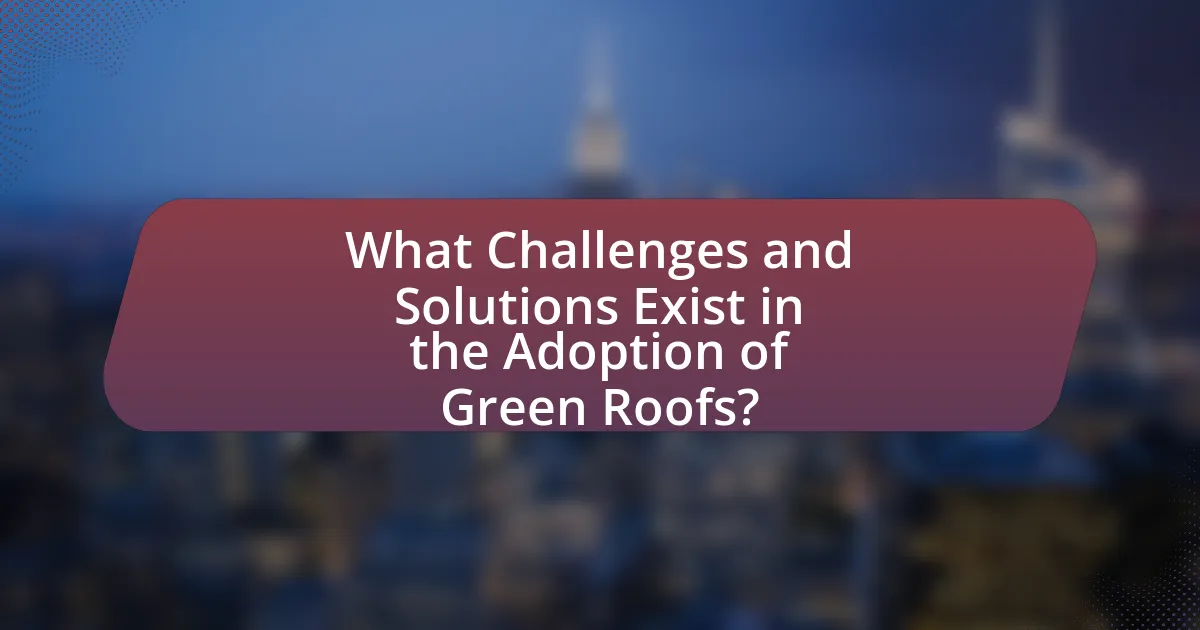
What Challenges and Solutions Exist in the Adoption of Green Roofs?
The adoption of green roofs faces several challenges, including high initial costs, structural limitations, and maintenance requirements. High initial costs can deter property owners from investing in green roofs, as installation can range from $10 to $25 per square foot, depending on the complexity and materials used. Structural limitations arise because not all buildings can support the additional weight of soil and vegetation, necessitating engineering assessments. Maintenance requirements include regular watering, weeding, and monitoring for pests, which can be resource-intensive.
Solutions to these challenges include financial incentives, such as government grants and tax credits, which can offset installation costs and encourage adoption. Structural challenges can be addressed through innovative design and engineering solutions, such as lightweight soil alternatives and modular green roof systems that distribute weight more evenly. Maintenance can be minimized by selecting drought-resistant plants and implementing automated irrigation systems, which reduce the need for manual upkeep.
What common obstacles do urban planners face with green roofs?
Urban planners commonly face structural, financial, and regulatory obstacles when implementing green roofs. Structural challenges arise from the need for buildings to support the additional weight of soil and vegetation, which may require retrofitting existing structures. Financially, the high initial costs of installation and maintenance can deter investment, despite potential long-term savings on energy and stormwater management. Regulatory hurdles often include zoning laws and building codes that may not accommodate green roof designs, complicating the approval process. These obstacles collectively hinder the widespread adoption of green roofs in urban architecture.
How can cost concerns be addressed in green roof projects?
Cost concerns in green roof projects can be addressed through careful planning, design optimization, and financial incentives. By conducting a thorough cost-benefit analysis, stakeholders can identify long-term savings from energy efficiency, stormwater management, and increased property value, which can offset initial installation costs. Research indicates that green roofs can reduce energy costs by up to 25% and extend roof lifespan by 50%, providing a compelling financial argument for investment. Additionally, utilizing modular green roof systems can lower installation costs and simplify maintenance, making projects more economically viable. Financial incentives, such as tax credits or grants from local governments, can further alleviate upfront expenses, encouraging broader adoption of green roofs in urban architecture.
What regulatory issues may impact green roof implementation?
Regulatory issues that may impact green roof implementation include zoning laws, building codes, and environmental regulations. Zoning laws can restrict the types of structures allowed in certain areas, potentially limiting green roof installations. Building codes may impose specific requirements for structural integrity and load-bearing capacities, which can affect the feasibility of adding a green roof. Environmental regulations, such as stormwater management requirements, can also influence design and implementation, as green roofs must comply with local guidelines for water runoff and ecosystem protection. These regulatory frameworks are essential for ensuring safety, sustainability, and compliance with urban planning objectives.
What innovative solutions are emerging to enhance green roof adoption?
Innovative solutions enhancing green roof adoption include modular green roof systems, advanced irrigation technologies, and integrated design software. Modular green roof systems simplify installation and maintenance, allowing for easier retrofitting on existing buildings. Advanced irrigation technologies, such as smart sensors and automated systems, optimize water usage, ensuring plant health while conserving resources. Integrated design software aids architects and urban planners in visualizing and planning green roofs, facilitating better integration into urban architecture. These solutions collectively address challenges related to cost, maintenance, and aesthetic integration, thereby promoting wider acceptance and implementation of green roofs in urban environments.
How can technology improve the efficiency of green roofs?
Technology can improve the efficiency of green roofs by integrating advanced monitoring systems and automated irrigation solutions. These technologies enable real-time assessment of plant health and moisture levels, ensuring optimal growth conditions. For instance, sensors can measure soil moisture and weather conditions, allowing for precise irrigation that conserves water and reduces waste. Additionally, the use of lightweight, engineered growing media enhances plant growth while minimizing structural load on buildings. Studies have shown that these technological advancements can increase the lifespan and performance of green roofs, leading to better thermal insulation and stormwater management.
What role do community engagement and education play in promoting green roofs?
Community engagement and education are crucial in promoting green roofs as they foster awareness, support, and participation among residents and stakeholders. Engaging the community through workshops, informational sessions, and hands-on projects helps individuals understand the environmental, economic, and aesthetic benefits of green roofs, such as improved air quality, reduced urban heat, and enhanced biodiversity. Educational initiatives can lead to increased public demand for green roofs, influencing policymakers to implement supportive regulations and incentives. For instance, cities that have invested in community education programs have seen a significant rise in green roof installations, demonstrating the effectiveness of informed public advocacy in driving sustainable urban development.
What are the best practices for incorporating green roofs in urban architecture?
The best practices for incorporating green roofs in urban architecture include selecting appropriate plant species, ensuring structural integrity, and implementing effective drainage systems. Choosing native and drought-resistant plants enhances biodiversity and reduces maintenance needs, while verifying that the building can support the additional weight of the green roof is crucial for safety. Additionally, a well-designed drainage system prevents water accumulation, which can lead to structural damage. Research indicates that green roofs can reduce urban heat islands by up to 5 degrees Celsius, demonstrating their effectiveness in improving urban environments.
